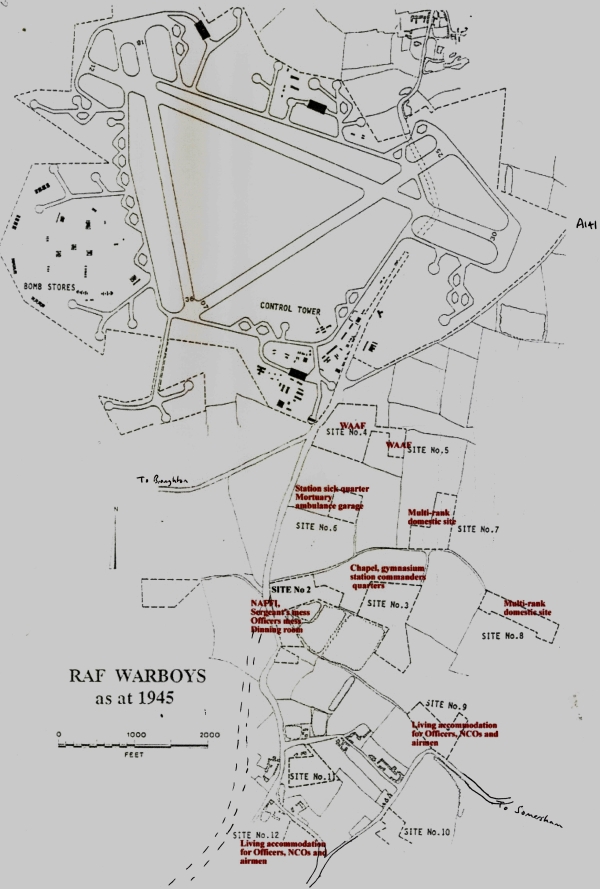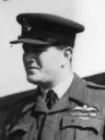RAF Warboys ~ Pathfinder Force Training Unit
Satellite to RAF Wyton September 1941 – achieved Full Station Status January 1943
PFF Navigation Training Unit (Lancaster lll NT) 23-26 March 44 Pathfinder Ops RAF Warboys
As a result of Experiments made over the Isle of Man, a new Technique was adopted in 1942, when a Flare Force, using Radar to ensure Accuracy, Lit the Target for the Main Force. In August 1942, the Pathfinder Force was formed from Squadrons drawn from each of the 5 Operational Bomber Command Groups and now located for purposes of Administration on Stations in No.3 Group, Exning but under the Operational Control of the AOC in C Bomber Command.
RAF PFF NTU Warboys 23rd March 1943 to 5th April 1944 A J L Craig – PFF Training Course 2 Weeks
Being posted to Warboys did not guarantee that the Crew would be accepted into the Pathfinders. Only about 50% of the selected Crews were passed and considered good enough to join a PFF Squadron. The Course included flying 4 “Mock Operations” before they were accepted as a PFF Crew.


During the early years of the War, RAF Warboys was a relatively conventional Bomber Station which was supplemented with the addition of an exceptionally long Main Runway measuring 6,290 feet. Construction of this runway resulted in the closure of the nearby road to Huntingdon (Church Road) during the War years, necessitating the construction of a By-pass Road, still in use (2015) as part of the A141. The extension to the Runway is still clearly visible, as crop marks between the Old & New roads. The Station was allocated to No.3 Group in August 1942. RAF Warboys became one of the original Pathfinder Force Stations. The construction of Warboys began in 1940. The Airfield was built to relieve the congestion at RAF Upwood for the use of No.17 Operational Training Unit (OTU) with Bristol Blenheim’s. The completion of barbed wire around strategic areas and 3 Ack-Ack gun positions with one Vickers Gun were almost finished by 17 May. Located on the Northside of the Site was the Battle Headquarters Bunker, defended by a pair of mushroom-shaped FC Construction type Pillboxes (also known as Oakington or Fairlop Type Pillboxes), one of which remains in good condition in 2009. The Airfield’s Bomb Stores were located to the West of the Airfield and to the North lay a Machine-gun Butt, used for testing, discharge & alignment of Aircraft Machine Guns. Domestic, Mess and Communal sites were dispersed to the South-east of the Airfield either side of the modern A141 on the borders of the neighbouring Village of Old Hurst. At least 11 separate dispersed locations provided maximum Accommodation for 1,959 male & 291 female Personnel.
The Airfield is located 7-miles south-west of Chatteris and South of Warboys Village. The Airfield was built in 1941-42. The Runways were extended before it was completed. To achieve the required length for the 12-30 Runway it was necessary to take it across the A141, so a new length of Public Road was built to by-pass the Airfield and the Village. The final Runway lengths were 12-30 at 2,097 yards, 07-25 at 1,447 yards and 18-36 at 1,350 yards. Twenty Four Pan Hard-standings were originally constructed but 2 of these were lost to Hangar construction. With 18 loop type hard standings added, the total of Aircraft Standings was 39. The Hangars were a T2 type on the Technical Site on the South-east side near the start of the new By-pass Road with another on the Northside and a B1 type East of the 18-36 Runway Head. The Bomb Stores lay off the Westside and 11 Domestic, Mess & Communal Sites dispersed either side of the A141 South to Old Hurst. The King & Queen Elizabeth came to visit RAF Warboys in February 1944 as a morale booster for 156 Squadron who had lost 17 Aircraft in 9 Operations in January 1944.
The PFF Crews thereafter found their way in the Force via varied Routes; Crews or individuals could Volunteer at any time while serving with Main Force Squadrons, while Aircrew who showed promise in their Training could also find themselves seconded into the Force. Some Crews in mid-Tour could also be transferred into PFF when numbers were needed to be made up to strength where required. Recruits were given a 2-week Course in Marking Techniques at Warboys before posting to a Squadron. Bennett addressed each intake personally and the Crews came to have an intense sense of Loyalty, Pride & Professionalism in their membership of 8 Group. The PFF crews were also granted a step up in Rank, and increase in Pay, but had to do a 45 Trip Tour rather than the usual 30 Trips, for as long as they were serving in PFF. In the end, Bomber Harris was proved wrong about PFF‘s effect on morale – the coveted PFF badge allowed to be worn on their Uniforms was genuinely a sought-after achievement.

It was estimated that during the winter of 1943/44 a Pathfinder Bomber Crew stood about a 15% chance of Survival. Warboys became an Operational Training Station with No. 8 Group’s Night Training Unit coming with Lancasters from Upwood and No. 1655 Mosquito Conversion Unit (MCU) was re-formed to provide Instruction on that Type. This Unit was absorbed by No. 16 OTU at Upper Heyford in December 1944 & the NTU continued part of the Mosquito Instructional Programme. A total of 99 Aircraft were lost on Wartime Operations from Warboys: 16 Wellingtons & 83 Lancasters.
Following VE-Day, the Training Establishment was dissolved and in July No.571 Squadron with its Mosquitos arrived from Oakington only to disband in September, the Airfield closing to flying at the end of 1945. On 15th December 1945, the Airfield was no longer in use and placed under care and maintenance. The Airfield gradually reverted back to Agricultural use with the buildings becoming derelict and the Runways & Hard-standings broken up.

46 Squadron Royal Flying Corps was formed at RAF Wyton in 1916 and on the 1st of April 1918, the Royal Air Force was formed at the Camp. Flying Training ceased there on the 25th March 2013 whereupon the Cambridge University Air Squadron was relocated to RAF Cranwell in Lincolnshire & RAF Wittering near Peterborough. The Pilots during WW2 were brave men, and as part of their Duties, were also called upon to Evaluate & Trial new equipment, which led to many tragedies for Aircrew & Local people alike. One such Tragedy was in on 5th October 1942 when a returning 156 Squadron Wellington Bomber (unmanned) crashed on houses as you enter Somersham, killing 10 local people in their Homes. The Target was Aachen in Germany. 257 Aircraft made up of – 101 Wellingtons, 74 Lancasters, 59 Halifaxes, 23 Stirlings were involved. A white Plaque hangs on the wall of the newly constructed homes at Carpenters Court on the corner as you enter Somersham, sadly many people pass it daily without knowing of its existence and the sacrifice made by Villagers.
The victims of the disaster, which turned the peaceful village street into a scene of devastation were:
Mrs Violet Moule 63, Mrs Vera Cattenach 23, her daughter, & Pauline Cattenack, 1-year-old, her granddaughter;
Frank Lamb 44, labourer and Mrs Alice Lamb, 70 his mother;
Mrs Elsie May Taylor, 49 and her mother, Mrs Annie Holdich 74, Mrs Taylor lost her husband (who was an Officer) in WW1. She had adopted a Soldier of his old Regiment, who used to visit her when on leave and whom she kept supplied with comforts.
Mrs Elizabeth Richardson 67, an evacuee from Norwich,
Mrs Eliza Nightingale 68, and Ena Stroud 15. Miss Stroud, who recently left school, lived with her parents, who were away moving furniture to a new house when the Wellington crashed.
The 2 last named died in Huntingdon County Hospital. The bodies of the remainder were dug out of the wreckage, those of Mrs Cattenach and Mrs Richardson not being recovered until 2.45 pm on Tuesday.
Mrs Lamb, Mrs Taylor, Mrs Holdich, Mrs Richardson, Mrs Moule were all Widows. Mr & Mrs John Nightingale, their married daughter, Mrs Eliza Davies, and the latters baby, Juliana, were all taken to Hospital, where Mrs Nightingale later succumbed. Mrs Davies and her daughter have serious burns; Mr Nightingale’s are not severe. Others rather badly hurt include Mr S Turner, who lodged with Mrs Moule, Mr Robert Brown (burned) and Miss Johnson, of Chapel Field (head injury).
What happened, in those few minutes which brought death & destruction to the Village, is best told in the words of Special Sgt E C Norman, who said to the Huntingdonshire Post:
I was sitting indoors at about 7.15 pm when I heard a plane revving overhead in a rather peculiar way. I went outside and saw 2 Planes flying around, with a sort of halo around them. I took them to be on fire. Shortly afterwards I saw a Plane flying at a great speed in a Southerly direction, in. a fairly shallow Power Dive. It came lower & lower and crashed into the houses in West End, which at once went up in a mass of flames. The cottages upon which the plane fell adjoined the White Lion Public House and several of them were Thatched. The aircraft, in crashing, took the Roof off a house in Rectory Lane occupied by Mr & Mrs Len Ruff (who were downstairs at the time and escaped injury), went clean through the Cottages on the White Lion side of the street, and ended up among the Cottages on the opposite side of the road.
A remarkable escape was that of Miss Wakelin, who is about 80 years of age and with whom Mrs Richardson (whose home at Norwich had been bombed) resided. Miss Wakelin was rescued almost unhurt from her blazing house.
Crew Unhurt
Nothing but a few pieces of twisted metal remained of the Aircraft on Tuesday morning. The Crew had baled out and landed safely on the Bluntisham – Old Hurst road, only the Pilot sustaining a twisted ankle. The blaze, which was visible for miles, was fought by NFS formations from Somersham (under Capt Brown), St Ives & Huntingdon, who were later relieved by crews from other parts of E Division. A plentiful supply of water was obtained from the hydrants. Column Officer Williams of Ely, told our Reporter that the local Firemen made a splendid job of it and deserved high praise. Members of the Somersham Platoon of the Home Guard set to work, soon after the crash, in lending whatever assistance was needed, and they, together with other Soldiers & airmen, did heroic work throughout the night and next day. Lieut Col E W Wilson, DSO (Commanding the 2nd Hunts Battalion of the Home Guard) stated: I am very gratified to know that my men did such fine work. The St. Ives Rescue Party (under Mr G G Yeandle, Borough Surveyor), was 1st on the scene, and later they had the aid of the County heavy rescue party (under Mr Christie). On Tuesday morning these were relieved by the Ramsey party (under Mr V J Bateman) and the Huntingdon party (Mr E J Saunders). All the rescue workers toiled valiantly and there was universal praise for their efforts. Fine work, too, was done by 2 Mobile Canteens one from Huntingdon and one from Chatteris. They served hot drinks, soup and sandwiches throughout the night.
The Aircrew of Wellington X3811:
P/O Thomas Edward Case aged 20 from Kelvington, Saskatchewan, Canada
P/O Harry William Welch from Canada;
Sgt Hugh Alexander McLennan DFM aged 26, from Albury, NSW Australia
Sgt Elias Cuthbert aged 30, from Donedin, Otago, New Zealand;
P/O Pierre Yves Camille Tremblay aged 29, from Canada.
This entire Crew, plus 2 new members necessary for the Lancaster, were lost on their next Mission to Wilhelmshaven on the 19th February 1943.
